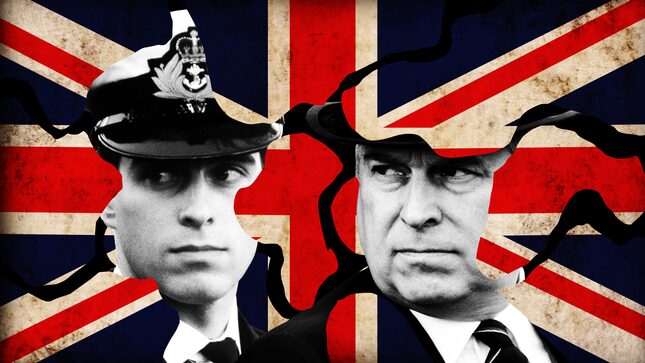The Story of ‘Randy Andy’
Prince Andrew has been something of a punchline for much of his adult life.
In Depth

Prince Andrew didn’t even make the cover lines on the October 18, 1976 issue of People magazine. (That was Captain & Tennille.) He was just 16 years old, and the focus was his relentless and—at that point—appropriately juvenile practical joking: “On some distant and solemn day, when Prince Charles is crowned king of England, he had better check his throne very carefully before sitting down. If his younger brother, Prince Andrew, is around, chances are a whoopee cushion will also be in the vicinity.”
By 1984, when he was 24 years old, Prince Andrew had acquired a bit more of a sheen, between his military service in Britain’s short-lived Falklands conflict and, of course, that title: “Would Prince Andrew find a Cinderella in Hollywood? That was the premise waiting for a script during His Royal Highness’ four-day stay in Los Angeles,” People asked, noting his flirtations with one woman in particular. That was the lead, anyway, before the loutishness reemerged, in an anecdote about how Andrew turned around during a tour of an abandoned house in Watts and sprayed the press corps following him with a paint compressor. Estimated damages: $20,000.
Prince Andrew has been something of a punchline for much of his adult life. The fairy tale role of Prince Charming has loomed large over him, but he’s never fit it, opting instead for puerile humor and blatant entitlement, never quite managing to deploy the kind of careful condescension in which royals like his nephew William are so skilled. Instead, Andrew has played the part of the “Playboy Prince,” known for decades in the tabloids as “Randy Andy,” almost a stock figure of buffoonish privilege straight out of a pantomime or an 18th-century satirical print.
But the name and the antics read very differently in light of the Epstein revelations, however, including the latest appalling details from the unpublished memoir of accuser Virginia Guiffre. Guiffre, who alleges that Epstein forced her to have sex with Andrew three times when she was 17, describes Andrew as groping her and another young woman at Epstein’s house with a puppet of himself from the satirical British program Spitting Image, the chilling echo of those early stories about practical jokes. The “Randy Andy” now seems like a case of the truth hiding in plain sight—a lesser charge that for years after Epstein’s conviction kept the Duke of York firmly in the realm of ridiculous rather than criminal.
Andrew was born in 1960, the third of Elizabeth and Philip’s four children. There’s nearly a full decade’s gap between Andrew and Anne, his next oldest sibling, and the children came at totally different points in their mother’s life. Charles and Anne were born when Elizabeth was taking on an increasing amount of responsibility for her father. When he died and she was elevated to the throne with unexpected suddenness, they were still small children, leaving her juggling parenthood and a job on the world stage. (With a small army of domestic help, of course.)
In contrast, Andrew was born when she was well-established in her role, and she took more time with her next two children: “Early in the 1960s, Her Majesty decided that she had done her duty by her country, and took the best part of eighteen months off work to produce and enjoy her ‘second family’, the young princes Andrew and Edward, born in 1960 and 1964 respectively,” historical advisor to The Crown Robert Lacey told Town and Country. And, too, Andrew was reportedly a cheerful, uncomplicated child: “Queen enjoyed the company of the easy-going son who could make her laugh and raise the family’s spirits,” Camilla Tominey at the Telegraph wrote in her assessment of Andrew’s fall. It’s long been rumored that the Queen has a special fondness for Andrew—a rumor that puts a pall on her current late-life popularity.
Andrew was raised in a princely splendor that even William and Harry wouldn’t recognize, as a friend pointed out in the Telegraph piece: “His nappies would have had royal crests on them.” His doings were, for instance, tracked in the New York Times beginning with front-page coverage of his name at birth: “Prince Andrew, 2, Has Party”; “Prince Andrew, 4, Begins School With 4 Playmates”; “Prince Andrew Will Get Midget James Bond Car.”
But he was always the spare, not the heir, and with the arrival of William and Harry in the early ’80s, he was knocked even further down the pecking order. He had a brief, shining flash of heroism in the Falklands War, where he served as a helicopter pilot. “If anything happened to him over there, there’d be an outrage, you can bet,” a bus driver in a pub told the New York Times for a piece about the conflict. He was treated as a serious voice from the conflict and greeted as a hero upon his return—the classic younger son shut out from the big-ticket inheritance but nevertheless distinguishing himself and his family with his military service in one of Britain’s colonial wars.
But he was even more famous as the “Playboy Prince”—or “Randy Andy,” as the tabloids took to calling him with their instinct for the jugular.-

-

-

-

-

-

-

-

-

-

-

-

-

-

-

-

-

-

-

-

-

-

-

-

-

-

-

-

-

-

-

-

-

-

-

-

-

-

-

-








































